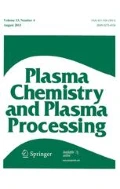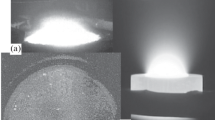Abstract
A coalesced high-intensity dc discharge is maintained between three cathodes and a single anode, stabilized by using resistors on each cathode leg. Jets of plasma gas are produced from either the cathode area or the anode area of the device. Cathode jets are generated by the self-induced pumping at the cathode tips and augmented by central gas injection. Arc voltage-current characteristics show classical convection-stabilized arc behavior. Anode heat transfer rates may be substantially increased by central gas injection toward the anode. Temperature fields in the coalesced, axially symmetric portion of the arc are determined spectrometrically and compared to those of a classical single-cathode free-burning arc.
Similar content being viewed by others
References
R. M. Young and E. Pfender, “Generation and Behavior of Fine Particles in Thermal Plasmas—A Review,”Plasma Chem. Plasma Process 5, 1–37 (1985).
C. Sheer, S. Korman, D. J. Angier, and R. P. Cahn,Fine Particles, 2nd Int. Conf., W. E. Kuhn and J. Ehretsmann, eds., Princeton, New Jersey, Electrothermics and Metallurgy Division, Electrochemical Society (1974).
R. K. Bayliss, J. W. Bryant, and I. G. Sayce, “Plasma dissociation of zircon sands,”Proceedings of the Third International Symposium on Plasma Chemistry (Limoges, France, 1977) S.5.2.
B. Pateyron and P. Fauchais, “Experimental study of steel vaporization and aerosol formation,”Proceedings of the Sixth International Symposium on Plasma Chemistry (Montreal, Canada, 1983), M. I. Boulos and R. J. Munz, eds., Vol. 2 (1983), p. 363.
Anonymous,Chem. Eng. November 24, 56 (1975).
D. Whyman, “A rotating-wall, d.c.-arc plasma furnace,”J. Sci. Instrum. 44, 525 (1967).
H. Maecker, “Plasmastroemungen in lichtbogen infolge eigenmagnetischer kompression,”Z. Phys. 141, 198–216 (1955).
C. Sheer, J. M. Kennedy, and P. S. Tschang, “Effects of mechanical and thermal electrode properties on the behavior of the fluid transpiration arc,” ARL-63-150, Aerospace Research Laboratories, Office of Aerospace Research, United States Air Force, August 1963. (Available NTIS#AD419199).
C. Sheer, P. S. Tschang, and C. G. Stojanoff, “Effects of mechanical and thermal electrode properties on the behavior of the fluid transpiration arc,” ARL-65-163, Aerospace Research Laboratories, Office of Aerospace Research, United States Air Force, August 1965. (Available NTIS#AD635872).
C. Sheer, S. Korman, C. G. Stojanoff, and P. S. Tschang, “Diagnostic study of the fluid transpiration arc,” AFOSR 70-0195TR, May 1969, Air Force Office of Scientific Research, Final Report F-1/312. (Available NTIS #AD706138).
J. E. Harry and R. Knight, “Simultaneous operation of electric arcs from the same supply,”IEEE Trans. Plasma Sci. PS-19(A), 248–254 (1981).
K. Etemadi and E. Pfender, “Computer-controlled plasma emission spectroscopy,”Rev. Sci. Instrum. 53, 255 (1982).
K. Etemadi, “Investigation of the anode boundary layer of high-current arcs by computer-controlled plasma spectroscopy,” Ph.D. Thesis, University of Minnesota, 1982.
L. M. Biberman and G. E. Norman, “Continuous spectra of atomic gases and plasma,”Sov. Phys. Uspekhi 10, 52–90 (1967).
T. L. Eddy, C. J. Cremers, and H. S. Hsia, “The MTE continuum relation with application to argon arc at atmospheric pressure,”J. Quant. Spectrosc. Radiat. Transfer 17, 287–296 (1977).
C. J. Cremers and R. C. Birkebak, “Application of the Abel integral equation to spectrographic data,”Appl. Opt. 5, 1057–1064 (1966).
J. F. Coudert, J. M. Baronnet, and P. Fauchais, “Diagnostic on a D. C. arc plasma jet using an optical multichannel analyser (O.M.A.),”Proceedings of the Sixth International Symposium on Plasma Chemistry (Montreal, Canada 1983), M. I. Boulos and R. J. Munz, eds., Vol. 1 (1983), pp. 102–107.
H. Magdeburg and U. Schley, “Spektralphotometrische eigenschaften des niederstrom-Kohlebogens,”Z. angew. Phys. 20, 465–473 (1966).
M. R. Null, and W. W. Lozier, “Carbon arc as a radiation standard,”J. Opt. Soc. Am. 52, 1156–1162 (1962).
H. N. Olsen, C. D. Maldonado, and G. D. Duckworth, “A numerical method for obtaining internal emission coefficients from externally measured spectral intensities of asymmetrical plasmas,”J. Quant. Spectrosc. Radiat. Transfer 8, 1419–1430 (1968).
A. J. Baker and D. M. Benenson, “Effects of forced convection upon the characteristics of a steady-state cross flow arc in the presence of an applied transverse magnetic field,”Proc. IEEE 59, 450–457 (1971).
K. Sauter, “Das temperatur-und stroemungsfeld in einen wandstabilisierten magnetisch abgelenkten bogen,”Z. Naturforsch. 24A, 1694–1706 (1969).
N. Sebald, “Measurement of the temperature and flow fields of the magnetically stabilized cross-flow N2 arc,”Appl. Phys. 21, 221–236 (1980).
Z. Y. Guo, “The temperature and flow field of a free-burning arc deflected by a transverse magnetic field,”Int. J. Heat Mass Transfer 27, 383–390 (1984).
J. R. Fincke, “Tomographic reconstruction of volume emission coefficients from line integral data,”Plasma Chem. Plasma Process. 6, 127–141 (1986).
Jia-Yush Yen, “Experimental study of a multi-cathode arc,” M.S.M.E. Thesis, University of Minnesota, 1983.
R. M. Young, “Thermal plasma processing of fine powders: heat transfer and synthesis in arc reactors,” Ph.D. Thesis, University of Minnesota, 1987.
N. Sanders, K. Etemadi, K. C. Hsu, and E. Pfender, “Studies of the anode region of a high-intensity argon arc,”J. Appl. Phys. 53, 4136 (1982).
J. Y. Yen, R. M. Young, P. Stuart, and E. Pfender, “A new method for injection of particulate matter into high-intensity DC arcs,”Seventh International Symposium on Plasma Chemistry, Eindhoven, The Netherlands, C. J. Timmermans, ed., Vol. 1 (1985) 201–206.
K. C. Hsu, K. Etemadi, and E. Pfender, “Study of the free-burning high-intensity argon arc,”J. Appl. Phys. 54, 1293–1301 (1983).
Author information
Authors and Affiliations
Rights and permissions
About this article
Cite this article
Young, R.M., Pfender, E. A novel approach for introducing particulate matter into thermal plasmas: The triple-cathode arc. Plasma Chem Plasma Process 9, 465–481 (1989). https://doi.org/10.1007/BF01023914
Received:
Revised:
Issue Date:
DOI: https://doi.org/10.1007/BF01023914




